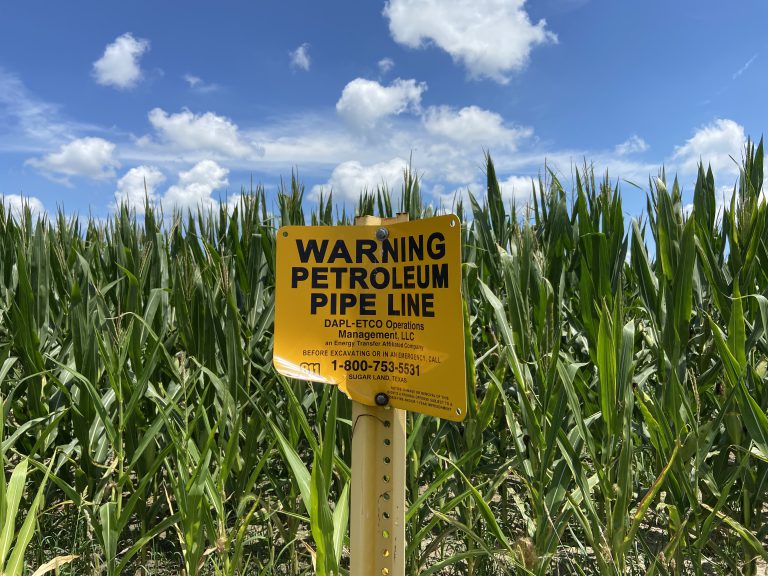PATOKA – This summer, a district court ruled the Dakota Access Pipeline had to be shut down until a more thorough environmental review was done. That ruling was recently overturned, with the pipeline allowed to operate indefinitely.
But multiple court battles continue.
Reporter Lecia Bushak traveled to south-central Illinois to look into one of the legal battles over the pipeline happening in the state:
Driving in his truck across bumpy country roads between corn and soy fields, Dave Schluckebier says his family has farmed these 3,200 acres in Montgomery County, Illinois, for five generations.
But now, several feet below those fields is a 30-inch-wide pipeline pumping half a million barrels of oil every day.
“Well, you can imagine, trying to put a 30-inch pipe underneath that ground, you gotta dig back that way, you gotta dig deep,” Schluckebier says. “It was one H of a mess is what it was.”

The Dakota Access Pipeline, or DAPL, runs more than 1,000 miles, from North Dakota to an oil terminal hub in Patoka, a small town in rural Illinois.
Four years after protests erupted at Standing Rock in North Dakota over the building of the pipeline, there is still an ongoing legal fight. Currently in Illinois, environmental groups are intervening in a case at the Illinois Commerce Commission against a proposal to double the amount of oil pumping through the pipeline from 500,000 to one million barrels per day.
“With what [the pipeline owners] want to do, there’s a danger of over-pressuring the pipeline and causing a rupture,” says John Albers, the lead attorney representing environmental groups in the case. “And that can happen anywhere along the route when you’re pumping that much oil that much faster.”
Albers says oil company Energy Transfer’s leak detection system cannot detect leaks that are less than 1% of the flow rate. And opponents argue even a small leak could lead to devastating consequences for soil and water.
“DAPL itself calculated that 458 barrels of crude oil could leak in one hour without detection,” Albers says. “And that’s from a pinhole leak, just a little tiny size of a pencil eraser type leak. So you could have that leak going on, and they would never know it.”
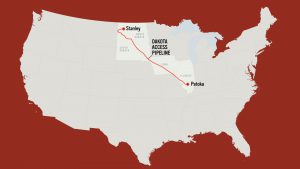
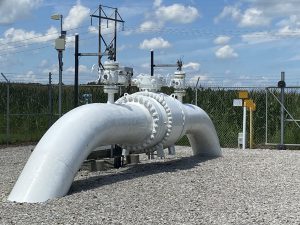
With the original shutdown order halted and Illinois’ battle over capacity expansion ongoing, some experts say the legal fight over the pipeline is far from over.
“Standing Rock was just one of many incidents that are ongoing,” says McKenzie Johnson, an assistant professor of natural resources and environmental sciences at the University of Illinois. “There’s a much longer arc to this story.”
Johnson is currently studying the long-term effects of the pipeline on land and farmers along its route in Illinois. The researchers’ preliminary results show that out of some 70 landowners they surveyed, most were worried about negative effects from the pipeline.
“I think close to 80% of our respondents said that environmental risks were probably their biggest concern, followed by leaks and spills, [and] loss of agricultural productivity,” Johnson says. “And I think around 40% of our respondents were concerned about future generations and the impact it might have on them.”
Back in south-central Illinois, Dave Schluckebier has noticed a difference in his soil four years after the pipeline was built.
He says his crops haven’t been the same. And his farm has seen a 25 to 50% reduction in crop productivity in the areas around the pipeline. He’s also concerned about potential leaks into groundwater.
“Heaven forbid [a leak] would happen, but it’s always in the back of your mind,” Schluckebier says. “But I mean, a 30-inch pipe gets a leak, it’s not going to take very long. And even if you get it shut off, I would assume your dirt would be contaminated. And if you get a leak it’s going to get into your groundwater.”
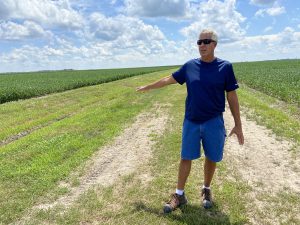
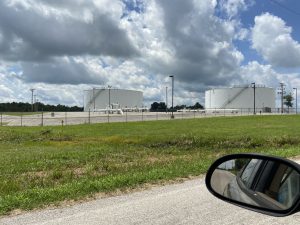
He says he supported protests led by the Standing Rock Sioux tribe in 2016, but felt he had little choice when Energy Transfer put the pipeline through his land under eminent domain.
“There were really hot protests that spring and everyone’s down here like, ‘Keep fighting them, keep fighting them, maybe it’ll stop it.’ But it didn’t happen,” he says.
It’s these concerns that have led opponents in Illinois to fight Energy Transfer’s plans to double the amount of oil running through the pipeline. Illinois is now the only state holding off on approving the permit.
Energy Transfer spokesperson Lisa Coleman said in an email that the proposed capacity expansion “will help ensure that Illinois and the rest of the country have an adequate supply of domestically produced oil and its by-products that make the comforts of our daily lives possible.”
She added that transporting oil through pipelines is safer and more environmentally friendly than doing it by trucks or railroads.
While the future of the Dakota Access Pipeline remains uncertain, McKenzie Johnson believes the continued legal battles may be a sign of shifting views on energy and the environment.
“People feel like we need to be headed in a new energy direction that’s away from fossil fuels, away from transporting them in these big pipelines towards renewable energy,” Johnson says. “Basically what states like Illinois have said is by constructing the pipeline, we’re committing to this form of energy production for at least another 100 years. And that’s an idea that people are pushing back against.”
In the meantime, Dave Schluckebier is left to grapple with the legacy of the pipeline on his farmland.
“It puts the pressure on me because I’m fourth generation, my son’s fifth, and he’s actually got the sixth generation now with him,” Schluckebier says.
“You’re kinda in the back of your mind thinking, ‘Man, I’m going to sign off on this. I hope it doesn’t ruin it for future generations. Am I doing the right thing, the wrong thing?’ But it finally just came down with, you really didn’t have much choice.”
This story is part of Illinois Public Media’s environmental reporting series, Prairie and Water. Follow environment reporter Lecia Bushak on Twitter: @Lecia_Bushak.

